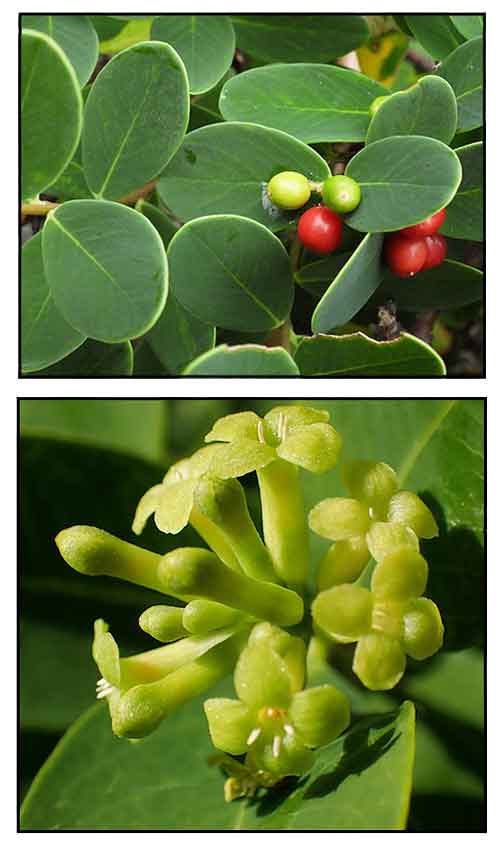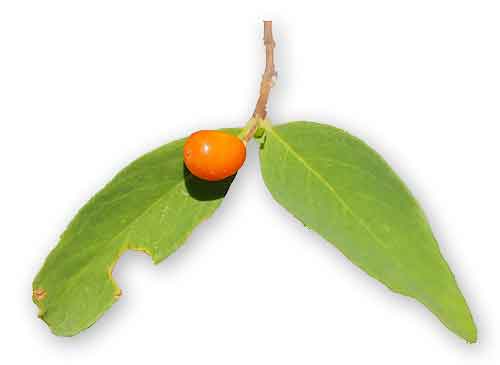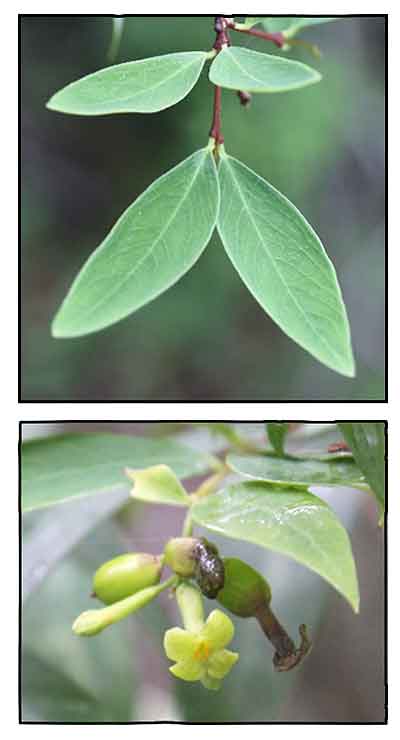 Gen info Gen info
- Wikstroemia is a genus of 93 species of flowering shrubs and small trees in the mezereon family, Thymelaeaceae.
- Wikstroemia indica is one of the 50 fundamental herbs used in traditional Chinese medicine.
(1)
- Etymology: The genus name Wikstroemia honors the Swedish botanist Johan Emanuel Wikström. The species epithet indica is Latin for "of India".
Botany
• Shrubs 0.5-2 m or more tall. Branches reddish brown, glabrous. Leaves opposite; petiole ca. 1 mm; leaf blade reddish brown on both surfaces when dried, obovate, elliptic-oblong, or lanceolate, 2-5 × 0.5-1.5 cm, papery to thinly leathery, both surfaces glabrous, base broadly or narrowly cuneate, apex obtuse or acute; lateral veins dense, slender, at narrow angle to midrib. Inflorescences terminal, capitate, several flowered; peduncle 0.5-1 cm, glabrous. Pedicel 1-2 mm. Calyx yellowish green, 7-12 mm, exterior glabrescent; lobes 4, broadly ovate to oblong, ca. 3 mm, apex acute or obtuse. Stamens 8. Disk scales often 2 or 4. Ovary obovoid or ellipsoid, glabrous or apex sparsely pubescent; style very short; stigma capitate. Drupe red to dark purple, ellipsoid, 7-8 mm. (Flora of China)
• Growth form: Shrub up to 2m tall or more. Foliage: Smooth, papery to thinly leathery leaves are obovate (egg-shaped with wider end near the tip), elliptic-oblong (elongated oval shape) or lanceolate (lance-shaped). Stems: Reddish brown branches are hairless. Flowers:Yellow, tubular flowers have 4 broadly ovate to oblong lobes (egg-shaped to elongated). The calyx or outermost layer of the flower is yellowish green. Fruits: Red, dark purple fruit is fleshy, pitted and botanically known as a drupe. The fruit is ellipsoid (oval-shaped) and 7-8 mm long. (Flora & Fauna Web)
Distribution
- Native to the Philippines.
- Also native to Assam, Bangladesh, Borneo, China South-Central, China Southeast, Hainan, India, Maluku, Myanmar, New Caledonia, New Guinea, New South Wales, Northern Territory, Queensland, Solomon Is., Sri Lanka, Sulawesi, Sumatera, Taiwan, Thailand, Vanuatu, Vietnam. (2)
C onstituents onstituents
- Extraction for flavonoids yielded four compounds: daphnoretin, chrysophanol, myricitrime, and rutin. (see study below) (5)
- Fractionation of ethyl acetate root extract isolated one new guaiane type sesquiterpene, indicanone (1), and two known biflavonoids, sikokianin B (2) and sikokianin C (3).
(see study below) (8)
- Study
of methanol extract yielded total phenolic (66.00 mg GAE/g), flavonoid (69.96 mg RE/g), phenolic acid (32.59 CE/g), and flavonol (4.46 mg CAE/g), higher compared to ethyl acetate and aqueous extracts. (9)
- Pyricularia oryzae-guided bioassay of roots isolated daphnoretin (1), (+)-nortrachelogenin (2), genkwanol A (3), wikstrol A (4), wikstrol B (5) and daphnodorin B (6). (see study below) (10)
- Study of roots isolated four new dilignans (1-4), which were screened for invitro activities against respiratory syncytial virus (RSV) with cytopathic effect (CPE) reduction assay. (16)
 Properties Properties
- Toxicity concern: The plant is toxic; poisoning can manifest as dizziness, blurred vision, nausea, vomiting, abdominal distention, abdominal pain and diarrhea. (1) Leaves and fruit are toxic. Death have been reported in children, dying after eating fruits of the plant.
There are reports of the bark being the most toxic part.
(4) (see study below: 6)
- Studies have suggested antimicrobial, antitumor, anti-inflammatory, analgesic, antioxidant, antifungal, anti-mitotic, anti-HIV 1, antidiarrheal, thrombolytic, antimalarial, antiviral, anticancer properties.
Parts used
Leaves, rhizomes, stems, roots.
Uses
Edibility
- Plant is reportedly poisonous. All plant parts, bark, leaves, and berries can cause poisoning. Leaves are poisonous to cattle; fruits more poisonous than leaves. Children reportedly dying after eating the fruits. (see above and study below: 6)
Folkloric
- No reported folkloric medicinal use in the Philippines.
- As traditional Chinese medicine, used as antipyretic, detoxicant, expectorant, vermifuge, and abortifacient. (1)
- Leaves are crushed and mixed with peanut oil to counter its irritant action, and applied externally as poultice against furunculosis and phelgmon.
- In China, rhizome used for treatment of syphilis, arthritis, whooping cough, and cancer.
Others
- Insecticide: Leaves can be used as insecticide in agriculture. (4)
- Fiber /Cordage / Paper: Smooth trunk has a tough bark that can be torn in strips and used as string. Fiber from the inner bark is light colored and silky in appearance, and can be used for making rope or high quality paper and, reportedly, bank notes. (4)
Studies
• Antimicrobial / Anti-Inflammatory / Antitumor: Study evaluated the extraction process of flavonoids and its multiple activities. Optimal extraction conditions were: 60% ethanol concentration, extraction time of 60 min; liquid-solid ration of16 at 160 w. W. indica extract exhibited significant antimicrobial and anti-inflammatory activities. Daphnoretin showed concentration-dependent antitumor effect, with significant inhibition of CNE cells and HeLa cells at concentrations range from 15.6 to 125 µg/ml. (see constituents above) (5)
• Toxicological Study/ Anti-Inflammatory / Antitumor: Wikstroemia indica is thought to be poisonous. Herbal doctors claim toxicity can be reduced by decocting for 3-5 hours. Study evaluated the acute toxicities of the crude drug and its aqueous and ethanolic extracts in mice. Cytotoxities were assessed using MTT and LDH assays. Decoctions were boiled for 1, 3, 5, 8, and 10 hours. Neither herb nor aqueous and ethanol extracts showed obvious toxicity in mice, with maximal tolerance doses higher than 18.7, 11.7, and 25.0 g/kg p.o., respectively. The 5 decoctions showed low cytotoxicity, with CC50 >1000 µg/mL. Results suggest W. indica is a relatively nontoxic herb and longer decoction times for reducing toxicity seems unnecessary. (6)
• Analgesic / Osthenol / Inhibition of Nav1.7 Channel / Stems: Study evaluated crude extract of W. indica stems for antinociceptive activity and the possible molecular basis of its analgesic activity. Crude extracts exhibited significant ability in mitigating the pain sensation, evidenced by substantial effects in both acetic acid-induced and heat-induced pain models. Osthenol was revealed as the key bioactive compound responsible for mediating the analgesic properties. Osthenol directly interacts with the pore domain of Nav1.7 channels, leading to channel inhibition. which is crucial in pain initiation, transmission, and modulation. Osthenol has potential in advancing development of antinociceptive drugs targeting the Nav1.7 channel. (7)
• Anti-Inflammatory / Sesquiterpene / Roots: Study evaluated an ethyl acetate extract of root of W. indica for inhibitory activity on nitric oxide (NO) production in a lipopolysaccharide (LPS) and recombinant mouse interferon-γ (IFN-γ) activated murine macrophage-like cell line, RAW 264.7. Fractionation of extract isolated one new guaiane type sesquiterpene, indicanone (1), and two known biflavonoids, sikokianin B (2) and sikokianin C (3). Compound 1 inhibited NO production with IC50 of 9.3 µM and also inhibited iNOS gene expression. (8)
• Chemical and Biological Effects: Study evaluated the chemical profile and biological effects of W. indica extracts. HPLC identified 31 compounds. The methanol extract showed great antioxidant activity. Extracts exhibited cytotoxic properties. The plant has potential to be utilized as a natural source of biologically active compounds. (see constituents above) (9)
• Antifungal / Antimitotic / Anti-HIV-1 / Roots: Pyricularia oryzae-guided bioassay of roots isolated daphnoretin (1), (+)-nortrachelogenin (2), genkwanol A (3), wikstrol A (4), wikstrol B (5) and daphnodorin B (6). Compounds 1-6 induced morphological deformation of P. oryzae mycelia with MMDC values range from 45.8 o 73.7 µM. Compounds 3-6 showed moderate activity against microtubule polymerization with IC50s range of 112 to 184 µg in vitro. Compounds 2, 3, 5, and 6 were moderately activity against HIV-1 in vitro. (10)
• Antidiarrheal / Thrombolytic / Leaves: Study evaluated the antidiarrheal and thrombolytic effect of W. indica leaf extract. Castor oil-induced diarrhea and enteropooling assays and gastrointestinal motility tests were used invivo for antidiarrheal assessment in Wistar albino rats, and invitro clot lysis model to investigate thrombolytic activity. Results showed inhibition of diarrheal episode by 18.64% and 28.96% for methanol extract at doses of 200 and 400 mg/kg respectively. Extract significantly (p<0.05) reduced intestinal volume and transit, reduced rate of defecation, accumulation of fluid and transit of charcoal oil. Extract showed moderate thrombolytic effect. (11)
• Antimalarial / Plasmodium falciparum / Roots: In an vitro antimalarial screening of medicinal herb extracts, the n-BuOH extract from root of W. indica showed potent inhibitory effect. Fractionation of active extract isolated two biflavonoids, sikokianin B (1) and sikokianin C (2) with IC50s of 0.54 µg/mL and 0.56 µg/mL, respectively, against chloroquine-resistant strains of Plasmodium falciparum. (12)
• Antiviral / Biflavonoid / Roots: Study of antiviral fraction of W. indica isolated a new biflavonoid, 4'-methoxydaphnodorin E against respiratory syncytial virus (RSV). The biflavanoid was tested for invitro anti-RSV activity with cytopathic effect (CPE) reduction assay, and displayed potent effect with IC50 of 2.8 µM and selective index (SI) value of 5.4. (13)
• Wikstromol / Apoptosis and Suppression of Migration of MDA-MB-231 cells: Triple negative breast cancer (TNBC) is the most severe type of breast cancer due to lack of specific targets and rapid metastasis, which result in poor prognosis. Study evaluated wikstromol frrom W. indica using human TNBC MDA-MB-231 cells. Wikstromol at 10 µM inhibited cell growth of MDA-MB-231 cells and induced apoptosis of cancer cells. At 0.1 µM wikstromol suppressed migration of cancer cells via decreasing transcription of NF-kB and reducing activity and secretion of downstream MMP-9. Also, p-PI3K and p-Akt were down-regulated in MDA-MB-231 cells with wikstromol 0.1 µM, indicating inactivation of P13K/Akt pathway was involved in the inhibitory effects. (14)
• Inhibition of Breast Cancer Lung Metastasis / Apoptosis and Suppression of Migration of MDA-MB-231 cells: Wikstroemia india has shown remarkable efficacy in antitumor treatment. Study evaluated the mechanisms involved in inhibition of breast cancer metastasis to the lung. W. indica inhibited the viability and proliferation of breast cancer cells and induced cell-cycle arrest and apoptosis. W. indica suppressed migration and invasion of breast cancer cells. Oral administration of W. indica significantly inhibited tumor growth in 4T1-tumor-bearing mice and the formation of lung nodules. Proteomic analysis showed down-regulation of expression of PRKCA protein. Study suggests W. indica inhibits lung metastasis of breast cancer by suppressing the proliferation and invasion of MDA-MB-231 cells through Focal adhesion signaling pathway. (15)
• Daphnoretin / Antiviral: Study screened fractions of ethanol extract of W. indica for antiviral activity against respiratory syncytial virus (RSV) using cytopathic effect (CPE) reduction assay. Fraction purification led to a purified compound, daphnoretin. Tested for anti-RSV activity using a plaque reduction assay, daphnoretic showed an IC50 of 5.87 µg/mL and SI value of 28.17. Daphnoretin could slightly inhibit the early events of the viral infection, but its effect was mainly on the later phase of the replication cycle. (17)
Availability
- Wild-crafted.
- Herbal products, seedsin the cybermarket.
|

![]()



 Gen info
Gen info onstituents
onstituents Properties
Properties